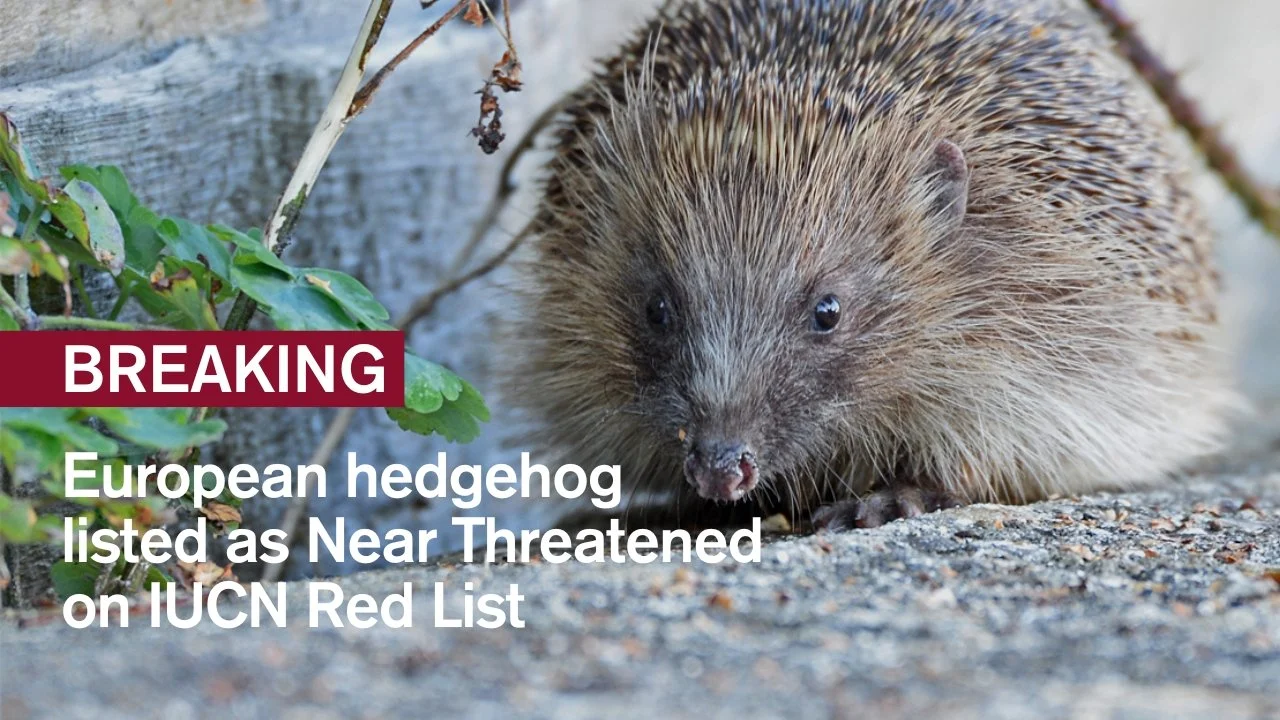Breaking: European hedgehog listed as Near Threatened on IUCN Red List
The conservation status of the West European Hedgehog (Erinaceus europaeus) has been updated from Least Concern to Near Threatened in the latest release of the IUCN Red List. This change is based on a decline that appears to be approaching, or exceeding, 30% in 10 years across many areas of its range.
“The change to the Western European hedgehog’s status comes after careful review of local, regional and national-level surveys from across its range. Unfortunately, evidence points towards a worrying and widespread downward trend. The Red List assessment also highlights data uncertainties – for example, the limits of this species’ distribution are not entirely clear, and there are gaps in knowledge of its populations. There is still a chance to halt the decline of the Western European hedgehog, and we must aim to prevent any further worsening of status,” explained Abi Gazzard, Programme Officer at IUCN SSC Small Mammal Specialist Group member.
West European hedgehog: Near Threatened
Once abundant across Europe, the West European hedgehog now faces a rapidly shrinking population. Urban development, agricultural expansion and road infrastructure have fragmented the hedgehog’s habitat, while vehicle collisions, the use of pesticides, and poorly managed gardens continue to reduce their numbers. Monitoring efforts indicate that their decline may exceed 30% over the past decade, putting the species at serious risk.
“This decline will likely come as no surprise to the average person. When hedgehogs come up in conversation, it’s not long before someone says that they just don’t see them anymore. The hope is that as hedgehogs become more and more like a distant memory from our childhoods, we will respond with action that will bring these memories back to life,” said Hope Nothhelfer, Communications Officer at the Mammal Society.
The importance of data collection for hedgehog conservation
The Mammal Society is calling on the public to contribute to hedgehog monitoring efforts by recording sightings through the Mammal Mapper app, and by joining forces with other nature champions through a local mammal groups. Collecting this data will help inform conservation strategies and focus protective measures in critical areas.
“We could not help hedgehogs across Chiswick without first collecting data to discover population hotspots. Using trail cameras (provided by London Hogwatch and the Mammal Society), we have been able to track hedgehogs for several years. Continued monitoring and recording are important so we can keep track of population numbers and create focused projects that encourage people to help hedgehogs,” said Joanne Gilbert, Chair of Wild Chiswick, a Mammal Society local group.
Wildlife-friendly garden management practices can help hedgehogs thrive in urban and rural areas alike. These include leaving small gaps in fences to allow hedgehog movement, reducing pesticide use, and providing food and shelter by creating log piles or hedgehog houses. Schoolgrounds and university campuses are an excellent opportunity for hedgehog habitat creation.
“Everyone can take simple steps to make an impact in reversing the steep decline in hedgehog numbers, such as providing a shallow dish of water, creating a hedgehog highway, and checking for nests before strimming. Collective small actions encourage young people to engage with wildlife, leading to a better overall understanding of supporting biodiversity – a key inspiration for starting my successful ‘Be Hedgehog Aware’ campaign at the age of 13. I’m delighted to be continuing to support conservation efforts as a Mammal Society Youth Ambassador,” said Dylan Allman, Youth Ambassador at the Mammal Society and Hedgehog Champion at Hedgehog Aware.
Hedgehog facts and statistics
The hedgehog, Britain's only spiny mammal, is unmistakeable. It is found throughout mainland Britain and Ireland and has been introduced to Orkney, Shetland, the Isle of Man, and some of the Channel Islands.
Hedgehogs are an indicator species of a healthy environment, as they feed on a variety of soil invertebrates. A decline in hedgehogs indicates a decline in the health of the ecosystem as a whole.
The biggest threat to hedgehogs is thought to be habitat loss, with the change from pastoral farming to arable crops, and increasing field size with the removal of hedgerows over the last 30 years. The use of chemicals in gardens and for intensive farming kills the creatures' hedgehogs need for food and may also poison them directly. Many are also killed on the roads.
One in four UK mammals are threatened with extinction, with many others in decline. The British Isles and Ireland are home to many species of mammal, from the tiny pygmy shrew to the giant blue whale. And yet, mammals are some of the most under-recorded species in Britain. Empowering conservationists, students, citizen scientists and nature champions to play a key role in grassroots conservation now and in the future ensures a bright future for mammals.
-ENDS-
For more information contact Hope Nothhelfer, Communications Officer at media@themammalsociety.org
About Mammal Society
Established in 1954, the Mammal Society is Britain’s leading charity devoted to the science-led conservation of mammals. They work to raise awareness of the issues mammals face, sharing scientific research so that populations can be protected and restored across the British Isles and Ireland. Ensuring a bright future for British mammals, the Mammal Society inspire conservation projects, empower stakeholders through training and resources, and raise public awareness through education and campaigns.
Mammal Society | Website | Instagram | LinkedIn | Facebook | Twitter

